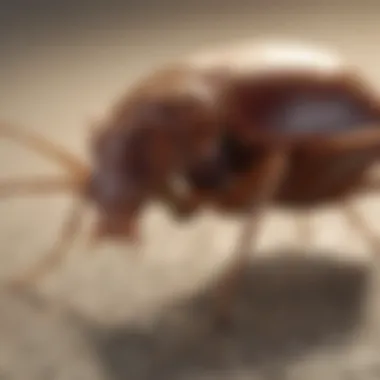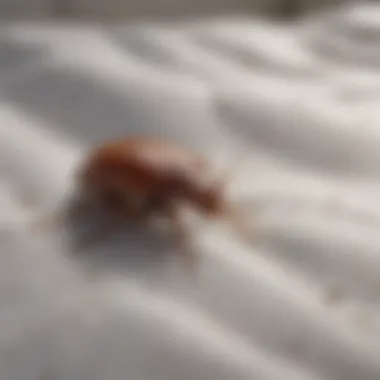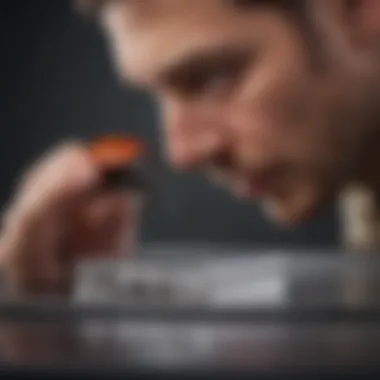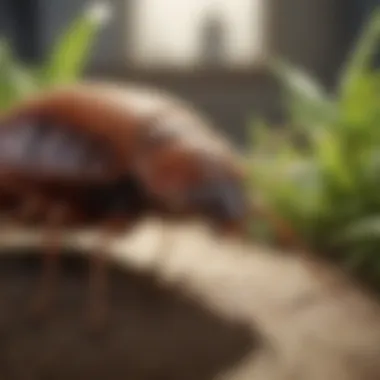Evaluating Orkin Bed Bug Treatment: An In-Depth Analysis


Overview of the Topic
Bed bugs are small, wingless insects that feed primarily on human blood. They thrive in warm environments and are often found in places like hotels, homes, and public transportation. Understanding the characteristics, behavior, and signs of infestations is essential for controlling these pests effectively. For agricultural and horticultural professionals, the presence of bed bugs can have serious repercussions, including financial damages and disruptions in operations.
Definition and Importance
Bed bugs, scientifically known as Cimex lectularius, are notorious for their resilience and rapid reproduction. Their bites can cause discomfort and lead to various allergic reactions. While these pests do not transmit diseases, their presence can have significant psychological effects on individuals facing infestations. Hence, effective management of bed bug populations is crucial.
Current Trends
The pest control industry has seen an increase in the adoption of integrated pest management (IPM) strategies that utilize a combination of chemical, physical, and biological controls. In newer pest control practices, there is a growing focus on sustainability and eco-friendly solutions. This includes the rise of steam treatments and heat treatments that eliminate bed bugs with minimal chemical intervention.
Key Techniques and Practices
Orkin is recognized for its comprehensive approach to bed bug treatment. Their methods combine inspection, treatment, and follow-up, creating a systematic process designed to eradicate infestations.
Step-by-Step Guide
- Inspection: Orkin professionals begin with a detailed inspection of the affected areas. They look for live bed bugs, shed skins, and signs of bites.
- Treatment Options: Treatments may include insecticide applications, heat treatments, or a combination of methods. Orkin's technicians customize strategies based on the specific infestation.
- Follow-Up: After initial treatment, Orkin provides follow-up visits. They assess effectiveness and make any necessary adjustments.
Tools and Equipment Needed
- Insecticides: Specialized formulas designed for bed bug control.
- Steamers: For heat treatment, powered steamers can effectively eliminate bed bugs in various stages of life.
- Vacuum Equipment: High-suction vacuums are used to remove bed bugs from infested areas.
Challenges and Solutions
While managing bed bug infestations, professionals encounter several common obstacles.
Common Obstacles
- Resistance to Insecticides: Bed bugs may develop resistance to certain chemicals, reducing treatment effectiveness.
- Hidden Infestations: Their tiny size allows them to hide in crevices, making detection difficult.
Innovative Solutions
To overcome these challenges, Orkin employs cutting-edge methodologies. They use specialized inspection tools that enhance detection. Additionally, employing heat treatments has gained traction because it effectively eradicates bed bugs in structures without requiring excessive chemical use. This strategy aligns with eco-friendly practices, crucial for sustainability in pest management.
"Understanding bed bugs and implementing effective management strategies is more significant than ever for agricultural sustainability and public health."
Understanding Bed Bugs
Understanding bed bugs is essential for effective pest management. This knowledge empowers individuals, particularly in agricultural settings, to recognize and respond to infestations promptly. Knowing the biology and behavior of bed bugs allows one to make informed decisions about treatments and preventative measures. It reduces reliance on pest control services by providing the tools for early identification and response.
Bed bugs are not merely a nuisance; they can significantly impact businesses and personal comfort. Their bites can lead to skin irritation and allergic reactions, while the psychological toll of having an infestation often leads to anxiety and sleeplessness. Additionally, infestations can have financial repercussions due to treatment costs and potential damage to property. By understanding the factors that contribute to infestations, such as travel patterns and living conditions, one can better strategize against them.
Biology and Behavior of Bed Bugs
Bed bugs, scientifically known as Cimex lectularius, are small, wingless insects with a brown color. They typically measure about 4 to 5 millimeters in length. Understanding their biology is crucial. Bed bugs undergo a simple metamorphosis. They start as eggs, hatch into nymphs, and mature into adults. Their lifecycle can be as short as several weeks, depending on environmental conditions and availability of hosts.
Bed bugs are nocturnal, feeding primarily at night, which makes detection difficult. They are attracted to carbon dioxide and body heat, which helps them locate their hosts. After feeding, they generally return to their hiding places, which are often crevices and seams in furniture and walls. They can survive for months without feeding, making eradication challenging.
Common Signs of Infestation
Detecting bed bugs early can prevent a small issue from becoming a widespread problem. Common signs of infestation include:


- Bites: Small, itchy welts on the skin, often appearing in clusters.
- Fecal Stains: Dark spots on bedding, walls, or furniture are indicative of bed bug waste.
- Eggs and Cast Skins: Finding these near sleeping areas can confirm their presence.
- Musty Odor: An unusual scent may indicate a significant infestation.
Identifying these signs quickly is vital for initiating effective control measures. Awareness and prompt action are key to managing bed bugs' impact.
Initial Assessment of Infestation
Understanding the initial assessment of bed bug infestation is crucial for effective pest control. Identifying the presence of bed bugs early on can prevent a simple issue from escalating into a much larger problem. This section delves into the specific elements involved in assessing an infestation. It covers the benefits of a proper assessment and considerations necessary to implement a successful treatment plan.
Diagnostic Tools and Techniques
The tools and techniques used during the diagnostic phase are integral to establishing the extent of an infestation. Employing a systematic approach is essential. Some common diagnostic methods include:
- Visual Inspections: Trained professionals look for physical evidence, such as adult bed bugs, shed skins, and fecal stains in common hiding spots like mattress seams, bed frames, and even wall cracks.
- Canine Inspections: Highly trained dogs paired with handlers can sniff out bed bugs with a high level of accuracy, often reaching areas that humans may overlook.
- Monitoring Devices: Sticky traps or interceptors can be placed strategically around the affected areas to capture bed bugs and provide ongoing surveillance of the infestation.
Each of these diagnostic tools has its merit, and the choice of which to employ often depends on the severity and location of the suspected infestation.
Importance of Professional Inspection
A professional inspection stands out as a pivotal component of the initial assessment process. There are several reasons why it is important:
- Expertise and Training: Pest control professionals have specialized training that enables them to identify signs of bed bugs that the average individual might miss.
- Comprehensive Evaluation: A professional can evaluate the entire property, increasing the likelihood of uncovering hidden infestations in less obvious locations.
- Tailored Action Plans: Based on the findings, professionals can develop tailored action plans that consider the unique circumstances of each case. This customized approach is often more effective than one-size-fits-all solutions.
- Safety Considerations: Handling pest problems can expose homeowners to harmful chemicals and practices. Professionals know how to navigate these dangers, ensuring safety for both residents and pets.
"Employing professional inspection helps to accurately identify the problem and suggests the best course of action, which can ultimately save time and resources."
Orkin's Bed Bug Treatment Protocol
Orkin's bed bug treatment protocol is a crucial component in understanding their approach to pest control. It provides a structured methodology for identifying and eradicating bed bugs, a pest known for its resilience. This protocol is designed not only to address existing infestations but also to prevent future occurrences. Key elements of the treatment protocol include thorough assessments, customized plans, and a variety of treatment methods. All these aspects work together to provide an effective response to bed bug infestations.
Assessment and Customized Treatment Plans
The first step in Orkin's protocol is assessment. This phase is vital as it establishes the extent of the infestation. Trained professionals gather data through various means, including visual inspections and possibly the use of monitoring devices. After evaluating the situation, Orkin develops customized treatment plans. Each plan is tailored to the unique challenges presented by the specific infestation. This relevanct tailoring maximizes the potential for success. Customized plans are informed by factors such as the size of the infestation, the locations most affected, and the specific environments involved. Overall, this initial step is critical in laying down an effective foundation for successful treatment.
Physical and Chemical Treatment Methods
Orkin employs both physical and chemical treatment methods in their pest management strategy. Each method serves distinct purposes and can enhance the effectiveness of the overall plan. Below are some key aspects of the methods used:
Heat Treatment
Heat treatment is a notable component of Orkin's strategies. It utilizes high temperatures to eliminate bed bugs in all life stages, including eggs. The key characteristic of heat treatment is its ability to penetrate various materials, effectively killing bed bugs hidden in furniture, mattresses, or baseboards. This makes it a popular choice among pest control options.
One unique feature of this method is that it relies solely on temperature without chemical residues. This is beneficial for those seeking eco-friendly options. However, it requires careful monitoring to ensure all areas reach effective temperatures, which might present logistical challenges in larger spaces.
Insecticides
Insecticides form another critical part of Orkin's treatment plan. These chemical agents are designed to target bed bugs directly, providing rapid knockdown and long-term residual effects. A key characteristic of insecticides is their versatility; various formulations are available for different environments, such as pyrethroids and non-pyrethroid options.
The unique feature of insecticides is their ability to be used in conjunction with other methods, which can enhance effectiveness. However, it's essential to apply them judiciously to avoid resistance development in bed bugs, thus careful selection and application are paramount in the protocol.
Vacuuming Strategies
Vacuuming strategies in Orkin's treatment protocol serve to physically eliminate bed bugs and their eggs from affected areas. The key characteristic of these strategies lies in their immediate effect—removing pests reduces the population directly. Vacuuming is also a beneficial choice as it helps in cleaning areas that cannot be treated with chemicals or heat.
A unique feature of vacuuming is that it can be done frequently throughout the infestation management process. This regular removal lowers the likelihood of a resurgence. However, while vacuuming is effective, it must be combined with other methods for comprehensive management, as it alone won't eliminate all bed bugs.


Follow-Up Care and Monitoring
Follow-up care and monitoring are pivotal after initial treatments. Orkin emphasizes the importance of maintaining vigilance and conducts regular check-ins with clients. These measures help identify any returning infestation. Continuous monitoring is essential, as bed bugs can be notoriously difficult to manage. Through strategic follow-ups, Orkin ensures that treatment methods remain effective over time and adjustments can be made when needed.
Comparative Analysis of Treatment Options
In the realm of pest control, especially in relation to bed bug infestations, a comparative analysis of treatment options is essential. This section underscores the key differences in methodologies and effectiveness between different pest control services. Such analysis helps individuals and businesses select a treatment that meets their specific needs, balancing efficacy with cost considerations. Understanding the comparative landscape is crucial, as it can directly influence financial expenditures and the overall success of the treatment process.
Orkin vs. Competitors
Orkin, a well-known name in pest control, offers a variety of bed bug treatment services. In comparing Orkin to its competitors, certain aspects must be closely considered. For instance, Orkin employs a multi-faceted approach that includes physical and chemical treatments tailored to the severity of the infestation. Competitors like Terminix and Rentokil may use similar techniques but can vary in execution.
- Methodological Differences: Each company may employ different strategies, such as heat treatments, chemical sprays, or integrated pest management approaches. Knowing which methods each competitor uses can provide insights into potential effectiveness.
- Service Packages: Orkin provides customized treatment plans that may cater to unique client needs. Evaluating options from other providers may reveal differences in service comprehensiveness and flexibility.
- Customer Satisfaction: This is a vital area. Reading consumer reviews and ratings on platforms like Reddit or Facebook can help in understanding user experiences, which can inform decisions.
"Choosing the right pest control service involves understanding the nuances of treatment options, customer feedback, and success rates across different platforms."
Effectiveness and Cost Considerations
When assessing the effectiveness of treatments, two main factors come into play: efficacy in eliminating bed bugs and the associated costs. Both Orkin and its competitors present varied options that differ in pricing and results.
- Efficacy of Treatments: Studies and user experiences suggest that treatments combining heat and insecticides tend to yield higher success rates. Orkin’s treatments focus not only on extermination but also on preventative measures to reduce future infestations. Comparatively, some competitors may offer less systematic approaches or fewer guarantees of long-term effectiveness.
- Cost Variables: Price is a major consideration for many clients. Orkin's prices might range depending on the size of the area being treated and the extent of the infestation. Competitors can present lower upfront costs but may not include follow-up treatments or guarantees that are critical in pest management. Evaluating long-term costs versus initial spending leads to a more informed decision-making process.
Ultimately, understanding the effectiveness and costs of these treatment options allows consumers to create a balance between financial investment and the likelihood of successful bed bug eradication. It is important to approach this analysis with a comprehensive lens, considering not just immediate results but also the potential for sustainable prevention.
Integrated Pest Management Approaches
Integrated Pest Management (IPM) is a crucial framework for addressing bed bug infestations in a sustainable and effective manner. This approach emphasizes the use of multiple strategies to control pest populations while minimizing environmental impact. The relevance of IPM within the context of bed bug control is paramount, as it highlights the need for an informed and holistic approach to pest management.
IPM combines various tactics, including biological, cultural, physical, and chemical methods. This multifaceted outlook provides a comprehensive perspective that not only seeks to eradicate existing infestations but also aims to prevent future ones. A key benefit of utilizing IPM is its focus on reducing pesticide usage, which aligns with growing concerns over chemical exposure and environmental health.
Here are some specific elements and benefits of IPM in bed bug management:
- Efficacy through Diversity: By employing a range of methods, IPM enhances the overall effectiveness of pest control efforts.
- Environmental Stewardship: IPM promotes the use of sustainable practices that are less harmful to non-target species and ecosystems.
- Cost-Effectiveness: Implementing preventative measures can lead to long-term savings by reducing the need for more intensive treatments.
In this context, prevention plays a significant role in IPM, making it necessary to integrate it into any effective bed bug management program.
Role of Prevention in Bed Bug Management
Prevention is a foundational aspect of Integrated Pest Management. It involves identifying conditions that foster bed bug infestations and implementing strategies to mitigate these risks. Effective prevention can significantly reduce the likelihood of encountering bed bugs in the first place. This could include simple actions such as inspecting secondhand furniture or using protective covers for mattresses. Educating the public about the signs of bed bugs and how they spread can also empower individuals to take proactive measures.
Sustainable Practices in Pest Control
Sustainable practices are essential for the long-term success of bed bug management strategies. They prioritize methods that reduce harm to the environment while effectively handling pest issues. Sustainable pest control recognizes that bed bugs are a persistent problem and advocates for approaches that maintain ecological balance.
Environmental Impact of Treatments
The environmental impact of treatments used in pest management is a critical area of concern. Addressing bed bug infestations often relies on chemical treatments, which can have far-reaching effects on the surrounding ecosystem. Selecting products that pose lower risks to environmental health can significantly contribute to sustainable pest control. Moreover, using methods like heat treatment minimizes chemical exposure and is an effective eradication method, underscoring its importance in sustainable practices.
Public Health Considerations
Public health considerations are integral to any discussion of pest control, particularly concerning bed bugs. Infestations can lead to physical discomfort, psychological stress, and even social stigmatization. Recognizing these implications is vital for developing a responsible pest management plan. The ability to manage bed bug populations effectively not only improves individual well-being but also enhances overall community health. Therefore, adopting Integrated Pest Management approaches that focus on both ecological and human health is critical in combating bed bugs effectively.
Case Studies and User Experiences


The exploration of case studies and user experiences is essential in evaluating Orkin's bed bug treatment efficacy. Such insights provide real-world context and contribute to an understanding of practical outcomes associated with the treatment protocols. They offer valuable information that goes beyond theoretical knowledge, revealing the complexities of implementing pest control solutions in varied environments. Moreover, these experiences highlight the importance of customer satisfaction and operational transparency in pest management services.
Successful Bed Bug Eradication Stories
Many clients have reported positive outcomes with Orkin's treatment methods. Numerous case studies illustrate how effective the approach can be when properly utilized. For example, an apartment complex in New York faced a severe bed bug outbreak that significantly affected tenants' quality of life. After enlisting Orkin's services, thorough inspections and a tailored treatment plan involving both heat treatments and insecticides were executed.
"Within just three treatments, we noticed a drastic reduction in bed bug sightings. Orkin truly understood our plight and delivered results," a tenant commented.
The success story of this apartment complex exemplifies how a well-planned treatment strategy can lead to eradication of bed bugs. The combination of treatment methods tailored to the specifics of the infestation allowed for a comprehensive solution that clients found reassuring.
Challenges Faced During Treatment Processes
Despite the success stories, the treatment of bed bugs is not without its challenges. Users frequently underscore issues they faced during the treatment process. Common problems include the necessity for extended preparation by residents. Residents are often required to declutter living spaces and wash bedding and clothing, which can be overwhelming for many.
Additionally, persistence is another hurdle; bed bugs are notoriously resilient. A user in a residential setting noted, "We had to go through multiple treatments. It felt daunting at times, but we eventually saw results."
Some treatments may initially seem ineffective, leading to frustration. It is vital for service providers, including Orkin, to maintain clear communication about the expected timeline and recurring treatments needed to ensure user trust throughout the process. Customers need reassurance that their concerns are valid and that the elimination will not only require patience but also active cooperation from their side.
Future Directions in Bed Bug Treatments
Addressing bed bug infestations is a critical challenge for pest control professionals today. As research progresses and public awareness grows, the need for effective solutions becomes increasingly apparent. The future of bed bug treatment rests on emerging technologies and enhanced integrated strategies that not only target the pests effectively but also align with sustainable practices. This section highlights these crucial developments in the pest control field, providing insight into their potential to revolutionize bed bug management.
Emerging Technologies in Pest Control
Adapting to the evolving nature of pests like bed bugs is essential. Emerging technologies in pest control promise to enhance the effectiveness of treatment protocols. For instance, advancements in smart monitoring devices enable real-time tracking of pest activity. These systems offer valuable data on infestation levels, allowing for timely interventions. Additionally, robotic systems equipped with specialized tools can target bed bugs in hard-to-reach areas, using precision to minimize chemical usage.
Moreover, the integration of biotechnology presents new avenues for controlling bed bug populations. Products derived from natural sources may provide effective alternatives to traditional insecticides. This approach may lead to treatments that not only eliminate bed bugs but also preserve beneficial insects in the ecosystem.
Potential for Enhanced Integrated Strategies
Integrated Pest Management (IPM) is essential for sustainable bed bug control. The potential for enhanced integrated strategies lies in the blending of biological, physical, and chemical control methods. IPM approaches emphasize prevention, monitoring, and control measures that minimize environmental impact.
Incorporating community engagement is also vital for effective control. Educating residents about best practices, such as regular inspections and proper sanitation, creates a shared responsibility towards pest management. This collaborative effort can significantly reduce the likelihood of infestations reoccurring.
Furthermore, research into the behavioral patterns of bed bugs can inform proactive measures. By understanding their habits, pest control strategies can be tailored to disrupt their life cycle, enhancing treatment efficacy.
"The future of pest control lies in technology and community engagement. A proactive approach will yield the best results in managing bed bug populations."
Epilogue and Recommendations
The Conclusion and Recommendations section holds great significance in this article as it encapsulates the findings and insights derived from the comprehensive exploration of Orkin's bed bug treatment options. This section is essential in guiding agricultural and horticultural professionals on effective management practices, encapsulating the key takeaways from the preceding analysis.
Emphasizing the methodologies and effectiveness of Orkin’s treatment protocols, the conclusions drawn here serve as a vital resource for pest management decisions. By synthesizing various strands of information, this section provides clarity on how to effectively address bed bug infestations, mitigating potential damage to crops or resources. Furthermore, it underscores the critical importance of integrating sustainable practices into pest control strategies, allowing professionals to enhance their approach while minimizing environmental impacts.
Additionally, the recommendations put forth are aimed at fostering long-term solutions. Listening to the experiences shared in the case studies enables pest control strategies to evolve. Thus, the conclusions serve not only as a summary but also as a roadmap for better pest management practices and informed decision-making in agricultural contexts.
Summary of Effective Management Practices
Effective management of bed bug infestations requires a multifaceted approach that incorporates various methodologies and ongoing monitoring. Some key practices include:
- Regular Inspections: Routine checks for signs of bed bugs can help in early detection, minimizing further infestations.
- Integrated Pest Management (IPM): Combining physical, chemical, and cultural measures to control pest populations while preserving beneficial insects.
- Education and Awareness: Training staff and farmers on recognizing bed bug signs can significantly enhance control efforts.
- Clear Protocols: Establishing clear guidelines for treatment methods helps ensure consistency and effectiveness.
In particular, Orkin has developed specific treatment plans tailored to individual infestations based on comprehensive assessments. This tailored approach is crucial in maximizing effectiveness and efficiency. Eradicating bed bugs decisively involves employing both immediate and preventative strategies, thereby ensuring long-lasting results.
Long-term Monitoring and Sustainability
The importance of long-term monitoring cannot be overstated in the context of pest management. Continuously observing treatment outcomes and the overall pest pressure in environments remains vital for successful bed bug control. Here are several aspects of long-term monitoring and sustainability:
- Follow-Up Visits: Regularly scheduled follow-up treatments ensure that any remaining pests are addressed swiftly.
- Data Tracking: Keeping records of treatment effects over time aids in understanding infestation patterns and success rates of specific methodologies.
- Sustainable Practices: Utilizing eco-friendly pest control methods not only protects agricultural ecosystems but also promotes public health.
Effective long-term strategies require collaboration among various stakeholders. Knowledge sharing around sustainable practices encourages innovation and responsiveness in pest control while benefiting the wider agricultural community. Ultimately, integrating monitoring with sustainable practices maximizes efficiency, aiding farmers in managing bed bugs without excessive reliance on chemical solutions.



